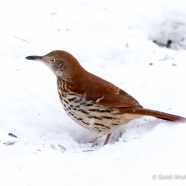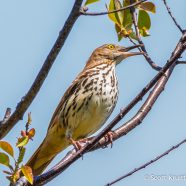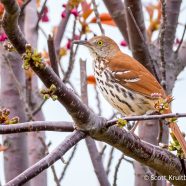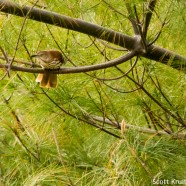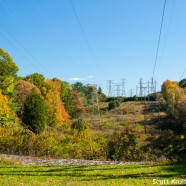Brown Thrasher Visit
This Brown Thrasher came to my feeders today! Talk about a welcome visitor…it ended up spending the day eating with various feathered friends, using that long bill to dig seed out of the snow. It was a delightful surprise for one of the more quiet times of the year. Scott Kruitbosch Conservation & Outreach Coordinator
Read MoreBrown Thrasher Singing
This Brown Thrasher (Toxostoma rufum) was another recent sighting of mine. It may be in a suitable nesting location – a blueberry patch – and was singing away from multiple perches. Another bird was nearby, and both were active and remaining in the same area. This does not necessarily mean they will make a nest here, but for now it is possible and perhaps probable. Look at that eye… Scott Kruitbosch Conservation & Outreach Coordinator
Read MoreBrown Thrasher
The Brown Thrasher (Toxostoma rufum) was another photographic target of mine this spring. I typically do get to enjoy the species a bit each April and May, but they are difficult subjects to shoot. Part of the problem is that they have dramatically dropped in abundance since Roger Tory Peterson’s time which makes me appreciate moments like these all the more. For a species that was a tolerably common breeding bird for many people, including Roger’s homes in New York and Connecticut, is now often a ghost in both behavior and population. Habitat loss and degradation, competition with...
Read MoreBrown Thrasher
This Brown Thrasher (Toxostoma rufum) has been avoiding my camera for at least two weeks now. It may have a mate, but I never end up spotting any true signs of probable nesting, and certainly lack any confirmations thus far. Sadly it is a far more notable sighting than it was back in Roger Tory Peterson’s day in the Northeast. The species has dropped dramatically in abundance, and what used to be a common breeding bird for many is now a ghost in behavior and population. I am still always startled by how boldly patterned, uniquely shaped, and even loudly musical they can be, yet often...
Read MorePowerline corridors, plants and wildlife
Powerline corridors, as well as gas and oil pipeline right of ways, are often an unexpected habitat oasis. They cover millions of acres of land in America. They may also provide a tremendous benefit to plants and wildlife that favor scrub or early successional habitat, a type that we do not favor in our development otherwise. Certain bees and butterflies to flowers and birds can all end up winning if these strips are managed properly – limiting mowing, chemicals, invasive plants and so forth. As humans have worked to protect forests we have neglected to do the same for this habitat...
Read More



